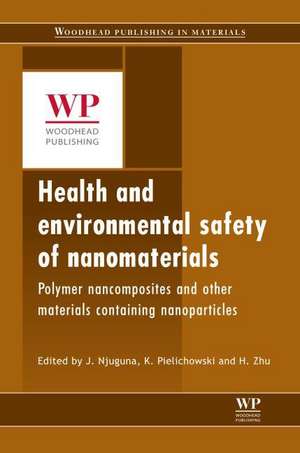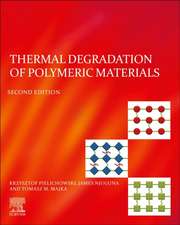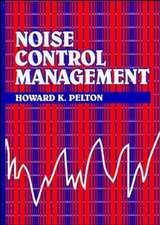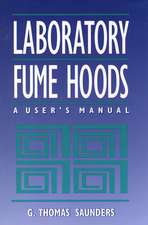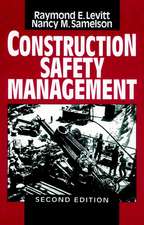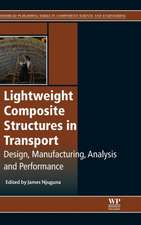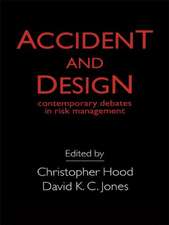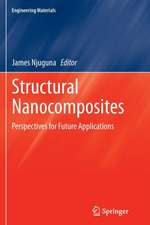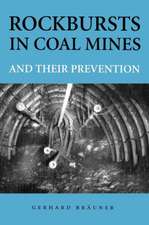Health and Environmental Safety of Nanomaterials: Polymer Nancomposites and Other Materials Containing Nanoparticles: Woodhead Publishing Series in Composites Science and Engineering
Editat de James Njuguna, Krzysztof Pielichowski, Huijun Zhuen Limba Engleză Hardback – 22 ian 2014
Part one introduces the properties of nanomaterials, nanofillers, and nanocomposites, and questions whether they are more toxic than their bulk counterparts. Part two looks at the release and exposure of nanomaterials. The text covers sampling techniques and data analysis methods used to assess nanoparticle exposure, as well as protocols for testing the safety of polymer nanocomposites. It explains characterization techniques of airborne nanoparticles and life cycle assessment of engineered nanomaterials. Part three focuses on the safety of certain nanomaterials, including nanolayered silicates, carbon nanotubes, and metal oxides. In particular, it explores the potential ecotoxicological hazards associated with the different structures of carbon nanotubes and the safe recycling of inorganic and carbon nanoparticles. The final two chapters address the risks of nanomaterials in fire conditions: their thermal degradation, flammability, and toxicity in different fire scenarios.
This is a scientific guide with technical background for professionals using nanomaterials in industry, scientists, academicians, research scholars, and polymer engineers. It also offers a deep understanding of the subject for undergraduate and postgraduate students.
- Introduces the properties of nanomaterials, nanofillers, and nanocomposites, and questions whether they are more toxic than their bulk counterparts
- Covers sampling techniques and data analysis methods used to assess nanoparticle exposure, as well as protocols for testing the safety of polymer nanocomposites
- Explores the potential ecotoxicological hazards associated with the different structures of carbon nanotubes and the safe recycling of inorganic and carbon nanoparticles
| Toate formatele și edițiile | Preț | Express |
|---|---|---|
| Paperback (1) | 1131.59 lei 5-7 săpt. | |
| ELSEVIER SCIENCE – 28 iul 2021 | 1131.59 lei 5-7 săpt. | |
| Hardback (1) | 925.09 lei 5-7 săpt. | |
| ELSEVIER SCIENCE – 22 ian 2014 | 925.09 lei 5-7 săpt. |
Din seria Woodhead Publishing Series in Composites Science and Engineering
- 29%
 Preț: 1153.66 lei
Preț: 1153.66 lei - 29%
 Preț: 1477.86 lei
Preț: 1477.86 lei - 24%
 Preț: 1160.48 lei
Preț: 1160.48 lei - 39%
 Preț: 1153.30 lei
Preț: 1153.30 lei - 24%
 Preț: 1451.12 lei
Preț: 1451.12 lei - 9%
 Preț: 1019.80 lei
Preț: 1019.80 lei - 29%
 Preț: 1129.94 lei
Preț: 1129.94 lei - 9%
 Preț: 1049.32 lei
Preț: 1049.32 lei - 29%
 Preț: 1067.77 lei
Preț: 1067.77 lei - 9%
 Preț: 1069.37 lei
Preț: 1069.37 lei - 29%
 Preț: 1326.23 lei
Preț: 1326.23 lei - 29%
 Preț: 1243.53 lei
Preț: 1243.53 lei - 29%
 Preț: 1213.41 lei
Preț: 1213.41 lei - 39%
 Preț: 1155.04 lei
Preț: 1155.04 lei - 9%
 Preț: 1006.50 lei
Preț: 1006.50 lei - 29%
 Preț: 1067.31 lei
Preț: 1067.31 lei - 9%
 Preț: 1140.31 lei
Preț: 1140.31 lei - 24%
 Preț: 1130.30 lei
Preț: 1130.30 lei - 9%
 Preț: 1069.99 lei
Preț: 1069.99 lei - 24%
 Preț: 1130.20 lei
Preț: 1130.20 lei - 9%
 Preț: 904.59 lei
Preț: 904.59 lei - 23%
 Preț: 999.53 lei
Preț: 999.53 lei - 9%
 Preț: 1542.98 lei
Preț: 1542.98 lei - 23%
 Preț: 992.64 lei
Preț: 992.64 lei - 9%
 Preț: 1210.03 lei
Preț: 1210.03 lei - 9%
 Preț: 1328.05 lei
Preț: 1328.05 lei - 24%
 Preț: 1563.73 lei
Preț: 1563.73 lei - 24%
 Preț: 1159.26 lei
Preț: 1159.26 lei - 24%
 Preț: 1559.63 lei
Preț: 1559.63 lei - 9%
 Preț: 1212.62 lei
Preț: 1212.62 lei - 29%
 Preț: 1158.40 lei
Preț: 1158.40 lei - 28%
 Preț: 1075.60 lei
Preț: 1075.60 lei - 29%
 Preț: 1158.75 lei
Preț: 1158.75 lei - 29%
 Preț: 1417.65 lei
Preț: 1417.65 lei - 9%
 Preț: 989.97 lei
Preț: 989.97 lei - 29%
 Preț: 1479.85 lei
Preț: 1479.85 lei - 9%
 Preț: 1335.20 lei
Preț: 1335.20 lei - 29%
 Preț: 1189.81 lei
Preț: 1189.81 lei - 9%
 Preț: 1069.82 lei
Preț: 1069.82 lei - 33%
 Preț: 946.33 lei
Preț: 946.33 lei - 24%
 Preț: 955.72 lei
Preț: 955.72 lei - 29%
 Preț: 1186.95 lei
Preț: 1186.95 lei - 29%
 Preț: 1393.64 lei
Preț: 1393.64 lei - 9%
 Preț: 1011.50 lei
Preț: 1011.50 lei - 9%
 Preț: 1071.27 lei
Preț: 1071.27 lei - 24%
 Preț: 1234.77 lei
Preț: 1234.77 lei - 9%
 Preț: 1208.48 lei
Preț: 1208.48 lei - 9%
 Preț: 1308.84 lei
Preț: 1308.84 lei - 29%
 Preț: 1311.49 lei
Preț: 1311.49 lei
Preț: 925.09 lei
Preț vechi: 1297.04 lei
-29% Nou
Puncte Express: 1388
Preț estimativ în valută:
177.01€ • 184.83$ • 146.17£
177.01€ • 184.83$ • 146.17£
Carte tipărită la comandă
Livrare economică 09-23 aprilie
Preluare comenzi: 021 569.72.76
Specificații
ISBN-13: 9780857096555
ISBN-10: 0857096559
Pagini: 344
Ilustrații: illustrations (black and white)
Dimensiuni: 156 x 234 x 25 mm
Greutate: 0.66 kg
Editura: ELSEVIER SCIENCE
Seria Woodhead Publishing Series in Composites Science and Engineering
ISBN-10: 0857096559
Pagini: 344
Ilustrații: illustrations (black and white)
Dimensiuni: 156 x 234 x 25 mm
Greutate: 0.66 kg
Editura: ELSEVIER SCIENCE
Seria Woodhead Publishing Series in Composites Science and Engineering
Cuprins
Contributor contact details
Woodhead Publishing Series in Composites Science and Engineering
Preface
Part I: General introduction
1. Nanomaterials, nanofillers, and nanocomposites: types and properties
Abstract:
1.1 Introduction
1.2 Key terms and definitions
1.3 Common physical and chemical properties
1.4 Types of nanofiller
1.5 Nanocomposites: selected examples
1.6 Conclusion
1.7 Acknowledgement
1.8 References
2. Mechanisms of nanomaterial toxicity
Abstract:
2.1 Introduction
2.2 Size- and non-size-related toxicity mechanisms of nanomaterials
2.3 Mechanisms of nanomaterial-induced cellular damage mediated by oxidative stress
2.4 Mechanisms of nanomaterial-induced cellular damage independent of oxidative stress
2.5 Nanomaterial shape and toxicity: the fibre paradigm
2.6 The use of lipidomics, proteomics, and transcriptomics to understand nanomaterial toxicity
2.7 Conclusion and future trends
2.8 References
Part II: Assessment of nanomaterial release and exposure
3. Nanoparticle exposure assessment: methods, sampling techniques, and data analysis
Abstract:
3.1 Introduction
3.2 Physicochemical properties of nanomaterials relevant to exposure assessment
3.3 International standards and guidance relating to nanoparticle exposure assessment
3.4 Instrumentation for exposure assessment
3.5 Sample collection strategies for exposure assessment
3.6 Initial evaluation: identification of potential emission sources
3.7 Main evaluation: key steps
3.8 Data interpretation
3.9 Conclusion and future trends
3.10 Acknowledgement
3.11 References
4. Sampling protocols for testing the safety of polymer nanocomposites
Abstract:
4.1 Introduction
4.2 Approaches for release simulation: case studies of drilling
4.3 Simulating the release of particulate materials
4.4 Collection of samples
4.5 Characterization of samples
4.6 Sample storage and labelling
4.7 Preventing the contamination of stored samples
4.8 Sample pre-treatment before testing: use of dispersing agents, sonication, stirring and mixing
4.9 Protocol validation and standardization
4.10 Conclusion and future trends
4.11 Sources of further information and advice
4.12 References
5. Measurement and sampling techniques for characterization of airborne nanoparticles released from nano-enhanced products
Abstract:
5.1 Introduction
5.2 Identification of release scenarios of nano-sized particles from nanocomposites
5.3 Measurement of airborne nano-sized particles
5.4 Collection of airborne particles
5.5 Deficiencies of devices for measuring airborne nano-sized particles
5.6 Case study: the effect of nanoclay on dust generation during drilling of PA6 nanocomposites
5.7 Conclusion
5.8 Acknowledgement
5.9 References
6. Life cycle assessment of engineered nanomaterials
Abstract:
6.1 Introduction
6.2 Life cycle assessment methodology
6.3 Life cycle assessment of engineered nanomaterials: case studies
6.4 New developments in life cycle assessment of engineered nanomaterials
6.5 Conclusion
6.6 References
Part III: Safety of particular types of nanomaterial
7. Nanolayered silicates/clay minerals: uses and effects on health
Abstract:
7.1 Introduction
7.2 Characteristics of clay minerals
7.3 Effect of clay minerals on the environment
7.4 Toxicity of nanoclays in humans
7.5 Life cycle assessment of nanoclay-reinforced materials
7.6 Conclusion and future trends
7.7 References
8. Carbon nanotubes: properties, applications, and toxicity
Abstract:
8.1 Introduction
8.2 Physico-chemical properties of carbon nanotubes and their applications
8.3 Carbon nanotubes in nanomedicine
8.4 Carbon nanotube toxicity
8.5 Conclusion and future trends
8.6 Acknowledgements
8.7 References
9. Ecotoxicological effects of carbon nanotubes: test methods and current research
Abstract:
9.1 Introduction
9.2 Quantification of carbon nanotubes in environmentally relevant media
9.3 Methodological issues
9.4 Current research on ecotoxicological risks of nanoparticles
9.5 Future trends
9.6 Conclusion
9.7 Disclaimer
9.8 References
10. Metal oxide nanomaterials: health and environmental effects
Abstract:
10.1 Introduction
10.2 Nano-zinc oxide
10.3 Nano-titanium dioxide
10.4 Other metal oxides
10.5 Conclusion and future trends: metal oxide nanomaterial regulation and risk assessment
10.6 Sources of further information and advice
Websites for general information
Government documents
Books
10.7 References
11. Safe recycling of materials containing persistent inorganic and carbon nanoparticles
Abstract:
11.1 Introduction
11.2 Recycling of engineered nanomaterials applied in suspensions
11.3 Recycling of nanocomposites
11.4 The range of recycling options
11.5 Nanomaterials present in wastes
11.6 Release of nanoparticles linked to recycling facilities
11.7 Conclusion
11.8 References
12. Nanostructured flame retardants: performance, toxicity, and environmental impact
Abstract:
12.1 Introduction
12.2 Fabrication of polymer nanocomposites
12.3 Conventional and nanostructured flame retardants
12.4 Flame retardant behaviour of polymer nanocomposites
12.5 Synergies from combining nanostructured flame retardants
12.6 Health and environmental risks of conventional and nanostructured flame retardants
12.7 Conclusion and future trends
12.8 References
13. Thermal degradation, flammability, and potential toxicity of polymer nanocomposites
Abstract:
13.1 Introduction
13.2 Thermal degradation processes of polymers and nanocomposites
13.3 Thermal stability of nanoparticles
13.4 Instrumentation and techniques to investigate degradation products of nanocomposites
13.5 Fire toxicity of degradation products of nanocomposites and its assessment
13.6 Intrinsic toxicity of nanoparticles
13.7 Ultrafine particle production during combustion of nanocomposites
13.8 Conclusion and future trends
13.9 References
Index
Woodhead Publishing Series in Composites Science and Engineering
Preface
Part I: General introduction
1. Nanomaterials, nanofillers, and nanocomposites: types and properties
Abstract:
1.1 Introduction
1.2 Key terms and definitions
1.3 Common physical and chemical properties
1.4 Types of nanofiller
1.5 Nanocomposites: selected examples
1.6 Conclusion
1.7 Acknowledgement
1.8 References
2. Mechanisms of nanomaterial toxicity
Abstract:
2.1 Introduction
2.2 Size- and non-size-related toxicity mechanisms of nanomaterials
2.3 Mechanisms of nanomaterial-induced cellular damage mediated by oxidative stress
2.4 Mechanisms of nanomaterial-induced cellular damage independent of oxidative stress
2.5 Nanomaterial shape and toxicity: the fibre paradigm
2.6 The use of lipidomics, proteomics, and transcriptomics to understand nanomaterial toxicity
2.7 Conclusion and future trends
2.8 References
Part II: Assessment of nanomaterial release and exposure
3. Nanoparticle exposure assessment: methods, sampling techniques, and data analysis
Abstract:
3.1 Introduction
3.2 Physicochemical properties of nanomaterials relevant to exposure assessment
3.3 International standards and guidance relating to nanoparticle exposure assessment
3.4 Instrumentation for exposure assessment
3.5 Sample collection strategies for exposure assessment
3.6 Initial evaluation: identification of potential emission sources
3.7 Main evaluation: key steps
3.8 Data interpretation
3.9 Conclusion and future trends
3.10 Acknowledgement
3.11 References
4. Sampling protocols for testing the safety of polymer nanocomposites
Abstract:
4.1 Introduction
4.2 Approaches for release simulation: case studies of drilling
4.3 Simulating the release of particulate materials
4.4 Collection of samples
4.5 Characterization of samples
4.6 Sample storage and labelling
4.7 Preventing the contamination of stored samples
4.8 Sample pre-treatment before testing: use of dispersing agents, sonication, stirring and mixing
4.9 Protocol validation and standardization
4.10 Conclusion and future trends
4.11 Sources of further information and advice
4.12 References
5. Measurement and sampling techniques for characterization of airborne nanoparticles released from nano-enhanced products
Abstract:
5.1 Introduction
5.2 Identification of release scenarios of nano-sized particles from nanocomposites
5.3 Measurement of airborne nano-sized particles
5.4 Collection of airborne particles
5.5 Deficiencies of devices for measuring airborne nano-sized particles
5.6 Case study: the effect of nanoclay on dust generation during drilling of PA6 nanocomposites
5.7 Conclusion
5.8 Acknowledgement
5.9 References
6. Life cycle assessment of engineered nanomaterials
Abstract:
6.1 Introduction
6.2 Life cycle assessment methodology
6.3 Life cycle assessment of engineered nanomaterials: case studies
6.4 New developments in life cycle assessment of engineered nanomaterials
6.5 Conclusion
6.6 References
Part III: Safety of particular types of nanomaterial
7. Nanolayered silicates/clay minerals: uses and effects on health
Abstract:
7.1 Introduction
7.2 Characteristics of clay minerals
7.3 Effect of clay minerals on the environment
7.4 Toxicity of nanoclays in humans
7.5 Life cycle assessment of nanoclay-reinforced materials
7.6 Conclusion and future trends
7.7 References
8. Carbon nanotubes: properties, applications, and toxicity
Abstract:
8.1 Introduction
8.2 Physico-chemical properties of carbon nanotubes and their applications
8.3 Carbon nanotubes in nanomedicine
8.4 Carbon nanotube toxicity
8.5 Conclusion and future trends
8.6 Acknowledgements
8.7 References
9. Ecotoxicological effects of carbon nanotubes: test methods and current research
Abstract:
9.1 Introduction
9.2 Quantification of carbon nanotubes in environmentally relevant media
9.3 Methodological issues
9.4 Current research on ecotoxicological risks of nanoparticles
9.5 Future trends
9.6 Conclusion
9.7 Disclaimer
9.8 References
10. Metal oxide nanomaterials: health and environmental effects
Abstract:
10.1 Introduction
10.2 Nano-zinc oxide
10.3 Nano-titanium dioxide
10.4 Other metal oxides
10.5 Conclusion and future trends: metal oxide nanomaterial regulation and risk assessment
10.6 Sources of further information and advice
Websites for general information
Government documents
Books
10.7 References
11. Safe recycling of materials containing persistent inorganic and carbon nanoparticles
Abstract:
11.1 Introduction
11.2 Recycling of engineered nanomaterials applied in suspensions
11.3 Recycling of nanocomposites
11.4 The range of recycling options
11.5 Nanomaterials present in wastes
11.6 Release of nanoparticles linked to recycling facilities
11.7 Conclusion
11.8 References
12. Nanostructured flame retardants: performance, toxicity, and environmental impact
Abstract:
12.1 Introduction
12.2 Fabrication of polymer nanocomposites
12.3 Conventional and nanostructured flame retardants
12.4 Flame retardant behaviour of polymer nanocomposites
12.5 Synergies from combining nanostructured flame retardants
12.6 Health and environmental risks of conventional and nanostructured flame retardants
12.7 Conclusion and future trends
12.8 References
13. Thermal degradation, flammability, and potential toxicity of polymer nanocomposites
Abstract:
13.1 Introduction
13.2 Thermal degradation processes of polymers and nanocomposites
13.3 Thermal stability of nanoparticles
13.4 Instrumentation and techniques to investigate degradation products of nanocomposites
13.5 Fire toxicity of degradation products of nanocomposites and its assessment
13.6 Intrinsic toxicity of nanoparticles
13.7 Ultrafine particle production during combustion of nanocomposites
13.8 Conclusion and future trends
13.9 References
Index
